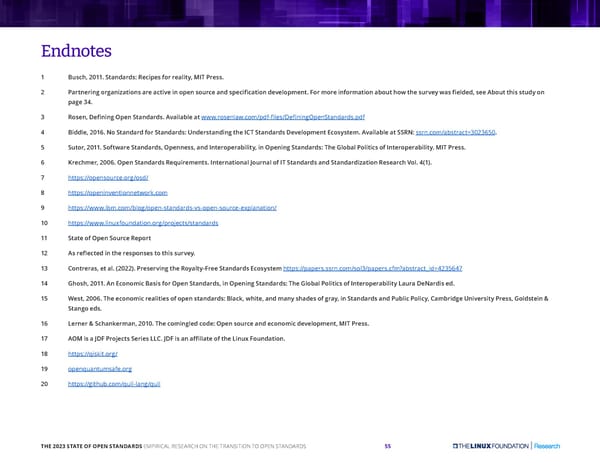Endnotes 1 Busch, 2011. Standards: Recipes for reality, MIT Press. 2 P artnering organizations are active in open source and specification development. For more information about how the survey was fielded, see About this study on page 34. 3 Rosen, Defining Open Standards. Available at www.rosenlaw.com/pdf-files/DefiningOpenStandards.pdf 4 Biddle, 2016. No Standard for Standards: Understanding the ICT Standards Development Ecosystem. Available at SSRN: ssrn.com/abstract=3023650. 5 Sutor, 2011. Software Standards, Openness, and Interoperability, in Opening Standards: The Global Politics of Interoperability. MIT Press. 6 Krechmer, 2006. Open Standards Requirements. International Journal of IT Standards and Standardization Research Vol. 4(1). 7 https://opensource.org/osd/ 8 https://openinventionnetwork.com 9 https://www.ibm.com/blog/open-standards-vs-open-source-explanation/ 10 https://www.linuxfoundation.org/projects/standards 11 State of Open Source Report 12 As reflected in the responses to this survey. 13 Contreras, et al. (2022). Preserving the Royalty-Free Standards Ecosystem https://papers.ssrn.com/sol3/papers.cfm?abstract_id=4235647 14 Ghosh, 2011. An Economic Basis for Open Standards, in Opening Standards: The Global Politics of Interoperability Laura DeNardis ed. 15 West, 2006. The economic realities of open standards: Black, white, and many shades of gray, in Standards and Public Policy, Cambridge University Press, Goldstein & Stango eds. 16 Lerner & Schankerman, 2010. The comingled code: Open source and economic development, MIT Press. 17 AOM is a JDF Projects Series LLC. JDF is an affiliate of the Linux Foundation. 18 https://qiskit.org/ 19 openquantumsafe.org 20 https://github.com/quil-lang/quil THE 2023 STATE OF OPEN STANDARDS EMPIRICAL RESEARCH ON THE TRANSITION TO OPEN STANDARDS 55
 The 2023 State of Open Standards Page 54 Page 56
The 2023 State of Open Standards Page 54 Page 56